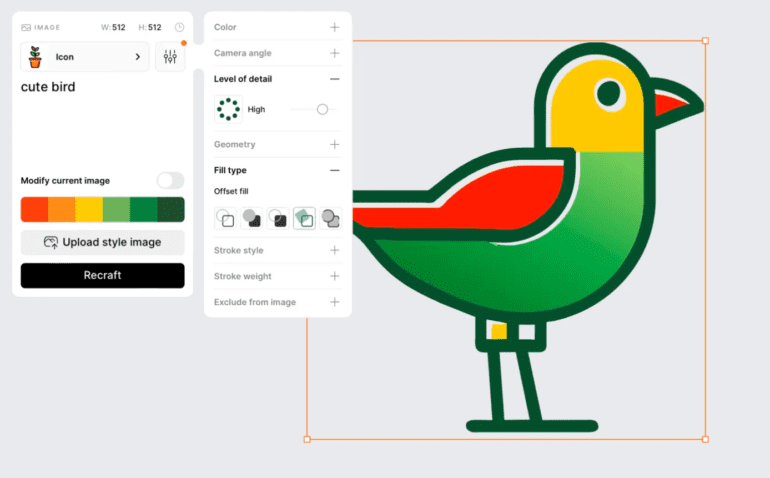TL;DR:
- Recraft secures $12 million Series A funding led by Khosla Ventures and former GitHub CEO Nat Friedman.
- The AI graphic design generator focuses on professional use, offering style control and consistent image generation.
- Recraft’s unique ‘foundational’ approach involves developing its Foundation Model for design elements.
- It has already attracted over 300,000 users within eight months of its launch.
- Unlike competitors, Recraft can generate both raster and vector images, catering to professional graphic design needs.
- Founder Anna Veronika Dorogush emphasizes user control over design outputs.
- Recraft addresses copyright concerns by not using artists’ reference images to train its model.
- The platform aims to make graphic design more accessible and improve the quality of creative content.
- Other players like Kittl are also in the AI-driven design space, with potential market impact.
Main AI News:
Amid the ongoing controversy surrounding AI-generated imagery, startups are forging ahead in the realm of AI tools for creative professionals. One such newcomer is Recraft, an AI graphic design generator that has secured a substantial $12 million Series A funding round led by Khosla Ventures in Silicon Valley, alongside former GitHub CEO Nat Friedman, RTP Global, Abstract VC, Basis Set Ventures, Elad Gil, and numerous angel investors.
While a multitude of Generative AI design tools already exists, including Jasper, Adobe Sensei, and Let’s Enhance, Recraft distinguishes itself by positioning as a ‘foundational’ tool. In essence, it develops its Foundation Model—a pre-trained, deep learning algorithm—to generate consistent design elements like icons and images. These elements can be adjusted to align with a brand’s specific style controls. Since its launch eight months ago, Recraft has amassed an impressive user base of over 300,000 professionals.
Recraft’s value proposition extends beyond whimsical creations like cowboy dogs on horseback. In addition to producing ‘raster images,’ it can also generate vector images, which offer infinite scalability and cater to the demands of professional graphic designers. This is in stark contrast to platforms where image quality often falls short.
The brains behind Recraft is none other than founder Anna Veronika Dorogush, a seasoned technical expert known for her creation of CatBoost, an open-source library for gradient boosting on decision trees. With a background as the former head of machine learning systems at Yandex in Moscow, Dorogush and her 13-member team now call London home.
In a recent conversation, Dorogush emphasized the importance of providing users with control over their creative outputs: “You have to provide a lot of control over the outputs to users… over the style so that you can get consistent images, and control over things like brand colors or level of detail, and also the ability to iterate on the resulting image.”
However, fine-tuning alone cannot suffice. Dorogush acknowledged that if the model cannot initially generate specific elements, like a pool player or a ballet dancer, it necessitates building their own model—a task currently underway at Recraft.
Recraft caters predominantly to professionals, offering not just image generation but also style control. This unique combination empowers users to craft their distinct style and subsequently generate images in that particular style—a vital feature for brand building, marketing material creation, and maintaining consistency in advertising campaigns.
Addressing concerns about potential copyright issues, Dorogush explained, “We do state in our terms that if an artist uploads something to the system as a sterile reference… we are not using those to train our model.” Instead, Recraft supplements images uploaded by artists with generic styles provided by the user, ensuring that the user defines the style.
Dorogush believes that Recraft will not replace graphic designers but rather make graphic design more accessible. The platform offers an alternative to uninspiring stock imagery, enabling authors of children’s books and other content creators to enhance their illustrations and imagery.
Recraft is not the sole player in this domain. Berlin-based Kittl, for instance, raised a €10.8 million ($11.6 million) Series A funding round last year for its design platform aimed at turning ideas into professional-grade designs rapidly. CEO Nicolas Heymann noted that tools like Recraft are part of an increasingly sophisticated toolkit for designers, potentially impacting the market for icon libraries.
Dorogush emphasized that there’s room for multiple players, highlighting Kittl’s unique focus on merchandise compared to Recraft’s emphasis on style-consistent imagery for graphic designers and marketers.
Investors appear enthusiastic about supporting business-oriented AI tools like Recraft, which aim to sidestep the controversies associated with some AI and design imaging platforms. Nikita Shamgunov, Partner at Khosla Ventures, stated, “We are seeing rapid and significant transformation of the design space driven by generative AI… Recraft delivers on professional workflows such as vector images, style controls, and end-to-end content production, all powered by in-house built foundation models.”
Conclusion:
Recraft’s innovative approach to AI-generated graphic design, focusing on professional users and style control, positions it as a promising player in the market. With its unique foundational model and ability to create both raster and vector images, it addresses the need for high-quality design elements. This signals a broader trend in the market, where AI tools are enhancing the capabilities of graphic designers and content creators, potentially reducing reliance on uninspiring stock imagery and contributing to the evolution of the design industry.

